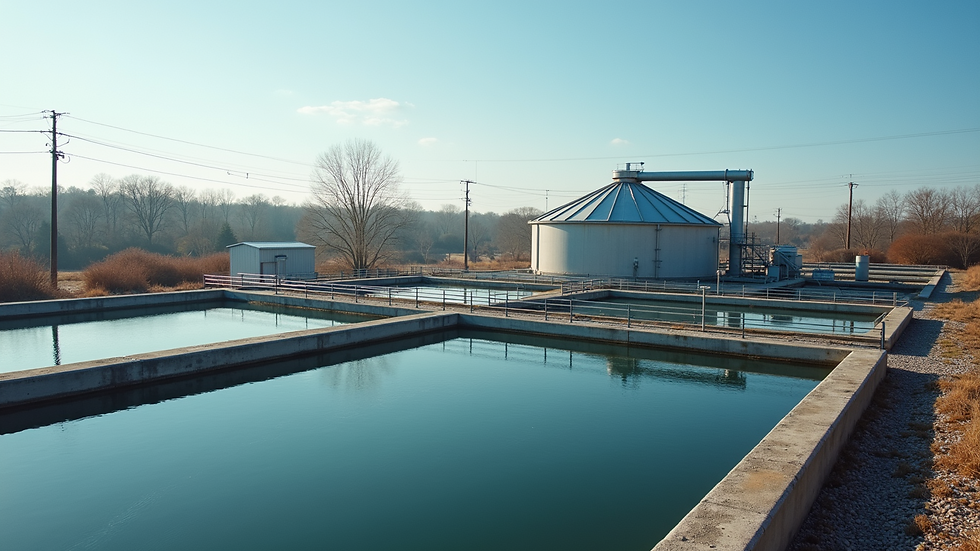Innovative Ways to Improve Wastewater Treatment
- palwinder kaur
- Aug 30
- 4 min read
Water is a precious resource, and treating wastewater effectively is crucial for environmental sustainability and public health. As industries and urban areas grow, the demand for advanced wastewater treatment solutions increases. Innovative technologies and methods are reshaping how we manage wastewater, making processes more efficient, cost-effective, and eco-friendly. This article explores cutting-edge approaches to improve wastewater treatment and highlights practical strategies that can be implemented today.
Advanced Wastewater Treatment Solutions for a Sustainable Future
Wastewater treatment has evolved significantly over the years. Traditional methods like sedimentation and biological treatment are now complemented by innovative technologies that enhance purification and resource recovery. Here are some of the most promising wastewater treatment solutions:
Membrane Bioreactors (MBRs)
Membrane bioreactors combine conventional biological treatment with membrane filtration. This technology offers several advantages:
Higher quality effluent: MBRs produce cleaner water by filtering out suspended solids and microorganisms.
Smaller footprint: They require less space compared to traditional treatment plants.
Flexibility: Suitable for both municipal and industrial wastewater.
MBRs are particularly effective in areas with limited land availability or where stringent discharge standards apply.
Advanced Oxidation Processes (AOPs)
AOPs use powerful oxidants like ozone, hydrogen peroxide, or UV light to break down complex organic pollutants that are difficult to remove by conventional methods. Benefits include:
Degradation of toxic compounds: Effective against pharmaceuticals, pesticides, and industrial chemicals.
Improved disinfection: Reduces pathogens without harmful by-products.
Enhanced biodegradability: Makes wastewater easier to treat biologically afterward.
Implementing AOPs can significantly improve the quality of treated water, making it safer for reuse or discharge.
Constructed Wetlands
Constructed wetlands mimic natural wetland ecosystems to treat wastewater through physical, chemical, and biological processes. They offer:
Low operational costs: Minimal energy and maintenance requirements.
Habitat creation: Supports biodiversity and enhances local ecosystems.
Aesthetic value: Can be integrated into urban landscapes as green spaces.
These systems are ideal for small communities or industries looking for sustainable, low-tech treatment options.

What do you mean by industrial waste management?
Industrial waste management refers to the processes and practices involved in handling waste generated by industrial activities. This includes the collection, treatment, and disposal of waste materials to minimize environmental impact. Effective industrial waste management ensures compliance with regulations, protects natural resources, and promotes sustainable operations.
In the context of wastewater, industries produce effluents containing hazardous chemicals, heavy metals, and organic pollutants. Proper treatment is essential to prevent contamination of water bodies and soil. Technologies such as chemical precipitation, ion exchange, and biological treatment are commonly used in industrial wastewater treatment plants.
For businesses seeking comprehensive solutions, industrial wastewater management services offer tailored approaches to meet specific needs, ensuring efficient and eco-friendly waste handling.
Emerging Technologies Revolutionizing Wastewater Treatment
Innovation continues to drive improvements in wastewater treatment. Some emerging technologies gaining attention include:
Electrocoagulation
Electrocoagulation uses electrical currents to remove contaminants by destabilizing particles and causing them to aggregate. This method is effective for:
Heavy metals removal
Oil and grease separation
Color and turbidity reduction
It is energy-efficient and produces less sludge compared to chemical coagulation.
Anaerobic Membrane Bioreactors (AnMBRs)
AnMBRs combine anaerobic digestion with membrane filtration, allowing for energy recovery through biogas production while treating wastewater. Advantages include:
Reduced sludge production
Lower energy consumption
Generation of renewable energy
This technology is particularly suitable for high-strength industrial wastewater.
Smart Monitoring and Automation
Integrating sensors, IoT devices, and AI into wastewater treatment plants enables real-time monitoring and process optimization. Benefits include:
Early detection of faults or contamination
Optimized chemical dosing and aeration
Reduced operational costs and energy use
Smart systems improve reliability and efficiency, making wastewater treatment more sustainable.

Practical Steps to Enhance Wastewater Treatment Efficiency
Implementing innovative technologies is important, but operational practices also play a critical role in improving wastewater treatment. Here are actionable recommendations:
Regular Maintenance and Training
Ensure equipment is well-maintained and staff are trained on the latest treatment methods and safety protocols.
Source Control
Minimize pollutant load by controlling industrial discharges and promoting waste reduction at the source.
Energy Optimization
Use energy-efficient pumps, blowers, and lighting. Consider renewable energy sources to power treatment plants.
Sludge Management
Implement sludge reduction and valorization techniques such as composting or anaerobic digestion.
Water Reuse and Recycling
Treat wastewater to standards suitable for reuse in irrigation, industrial processes, or cooling systems, reducing freshwater demand.
By combining technology with best practices, wastewater treatment facilities can achieve higher performance and sustainability.

Looking Ahead: The Future of Wastewater Treatment
The future of wastewater treatment lies in integrating multiple innovative approaches to create resilient, adaptable systems. Key trends include:
Circular Economy Models: Transforming wastewater treatment plants into resource recovery hubs that extract energy, nutrients, and clean water.
Decentralized Treatment: Small-scale, modular systems that serve local communities or industries, reducing infrastructure costs.
Green Infrastructure: Combining natural and engineered solutions to manage stormwater and wastewater sustainably.
Adopting these trends will help address growing water challenges while protecting the environment.
Innovative wastewater treatment solutions are essential for sustainable water management. By embracing advanced technologies, optimizing operations, and promoting resource recovery, we can ensure cleaner water for future generations. For industries looking to improve their wastewater handling, exploring specialized industrial wastewater management services can provide customized, effective solutions.



Comments